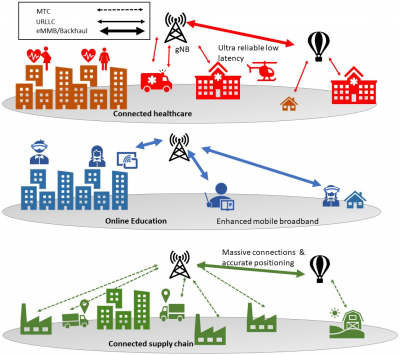Hamed Ahmadi, University of York, UK, Konstantinos Katzis, European University, Cyprus, Muhammad Zeeshan Shakir, University of West of Scotland, UK, Mahnaz Arvaneh, University of Sheffield, UK, Alan Gatherer, Futurewei, USA
Published: 17 Apr 2020

CTN Issue: April 2020

A note from the editor:
At this moment of global crisis, the role of telecommunications in keeping people connected and working has been phenomenal. Much of this is simply down to being the backbone that allows streaming media, social networking and video conferencing to ramp up to new levels of activity. In this article, we would like to focus specifically on 5G wireless cellular technology and ask the deeper questions of how this technology may contribute and what new requirements this pandemic may spur within the embryonic 6G effort. We are sure to have missed something so your comments are most welcome.
Muhammad Zeeshan Shakir, Editor
Alan Gatherer, Editor-in-Chief
Wireless Communication and the Pandemic: The Story So Far





The World Health Organization (WHO) recognized COVID-19 as a pandemic and almost all countries in the world have been affected by it one way or another. Many countries like Italy, Spain, Germany, France and the UK have declared full or partial lockdown and people are advised not to leave their homes unless necessary. In this difficult time, the UK announced a list of professions as key workers who will remain active and serve the society during the lockdown. This list includes doctors, pharmacists, National Health System workers, police and security forces, and telecommunication networks engineers/workers. Universities are retooling research projects to design low cost ventilators and data analytic engines to track outbreaks. Everyone is asking what they can do to help. Motivated by this, in this article we will have a look at the role of wireless telecommunications so far during the COVID-19 pandemic. Given that many of these nascent efforts may not come to fruition in time to help with the current outbreak, we also ask what the potential of networks beyond current 5G will be in reacting to similar situations.
While the healthcare system, nurses and doctors are at the frontline of fighting the pandemic and protecting patients, others have to stay at home and maintain social distancing. This means that many people need to work from home using internet-based technologies. At this point, it can be argued that the load is mainly on the fixed networks which connect homes. However, this does not reduce the importance of cellular networks, but emphasizes on key design challenges of 5G and its different verticals. Figure 1 shows use of 5G technologies for considered verticals such as healthcare, education and retail during a Pandemic situation. In this lockdown situation, reliability, availability, and resilience of the cellular network are very important. To better justify the point, let us review the position of these three crucial industries/verticals during the COVID-19 lockdown first and then relevant mobile communications technologies.

5G Verticals and Pandemic
In this section, we present the importance of mobile connectivity to healthcare, education, and retail sectors in supporting society and economy and doing social-economic good during pandemics like COVID-19.
Connectivity for Healthcare
5G mobile technologies can reliably connect hospitals, ambulances and homes to make the healthcare service more resource efficient and more effective to manage Pandemic together with normal operations. Connected ambulances can have high quality video calls with doctors and specialists in the hospital to attend the patient remotely and more suitably, especially under ongoing social distancing measures. Services such as artificial intelligence enabled remote patient monitoring and diagnoses can be supported by 5G networks to allow anyone with a medical condition to report back to their local or central healthcare system without having to physically be present [1]. This is especially important for people living in more remote areas. Due to travel restrictions caused by the COVID-19 outbreak, it may be difficult or impossible for many patients and surgeons to attend more equipped hospitals typically located in larger cities. However, surgeries and treatments are still essential. 5G-enabled remote surgery, or in a larger scale internet of skills [2], enables the patients to attend a nearby hospital and receive treatment/surgery from a doctor hundreds of miles away. Of course this requires ultra-reliable low-latency communication (URLLC) and very high data-rate [3]. Robots have been already used to perform duties/activities in environments that humans cannot go or it is life threatening to go. COVID-19 infected areas are among these environments. Companies like UVD-Robots and Ubibot used robots for COVID-19 disinfecting hospital rooms using UV light. Similar robots have been used for passenger temperature checking (day) and UV light disinfection (night) in the airport. Positioning and maintaining the connection for controlling the robot requires reliable and fast connection links of 5G technologies.
Another use of such wireless communication systems is the effective tracing of potential COVID-19 contacts whereabouts by employing cellular network type of localisation techniques and offer disease management via integrated personalise mobile Apps. Similar form of localisation techniques can be used to implement social distance measures. In many countries, the government, with the help of the military, has set up temporary hospitals, e.g. National Health System Nightingale hospitals in the UK, due to the sudden increase in the number of patients requiring intensive care. These hospitals are sometimes placed in areas that are not perfectly covered with the required cellular capacity demand and need new approaches of providing coverage and capacity with wireless backhauling techniques such as using low altitude platforms, e.g. Helikites [4,5]. Electric Vehicles (EVs) which are parked at the residential spots during Pandemic can be used to mobilise the stored energy and fulfill the energy demands to run the cellular network at these temporary sites or to meet the other energy demands at the hospitals. To make it happen, EVs will be required to use Vehicle to Grid (V2G) and Vehicle to Infrastructure (V2I) communication through 5G technologies and route the distributed EVs to the desired energy demand [6].
Connectivity for Education
When many countries announced partial lockdown, the education sector was among the first massively impacted as schools and universities discontinued in-person classes and worked to quickly transition to online classes so that students could continue their education. Nevertheless, this approach has surfaced a number of techno- socio-economic issues. More specifically, students and instructors living in rural areas experience limited coverage/Quality of Service (QoS) as their fixed broadband connection or cellular service is much slower than in urban areas. In addition to this, current broadband wired and cellular networks have experienced increased network traffic and may not support good quality video streaming. According to NOKIA’s network traffic insights in the time of COVID-19 [7] a cumulative increase between 30%-50% over ‘normal’ weekend peak traffic has been observed. The increase observed on weekdays was mainly due to the increased videoconferencing activities during business hours (symmetrical high-bandwidth traffic) whereas during weekends it was mostly due to streaming video such as Netflix and YouTube. In the US, conferencing applications such as Zoom experienced over 700% of growth from the 1st of February. All these technical issues directly impact the smooth operation of online classes, thus disrupting the online learning experiences.
Apart from the technical limitations of the current infrastructure, some socio-economic issues appeared when low-income families could not financially support wired-broadband connectivity at home, thus leaving some pupils outside the online classes. 5G mobile technology is a promising solution that can address most of the aforementioned shortfalls of the current wired and cellular networks offering true online education experience in cases like this. 5G can be employed to support multimedia streaming or to deliver educational material through Virtual Reality (VR), Augmented Reality (AR), and Mixed Reality (MR) for enhanced learning experiences. It can also address traffic generated by online meeting platforms and optimise the resources in real time through self organising networks (SON). In addition to these platforms, Universities will also require 5G technology in order to support immersive experiences for class and laboratory experience through applications such as Remote Laboratories (RL), Robotics and Internet of Things (IoT) embedded applications for Science Technology Engineering and Mathematics (STEM) education.
Connectivity for Retail and Supply Chain
Panic buying and supply chain disruption due to shortage of staff and delay in deliveries caused potential shortage of food and supplies in some areas. An efficient order placement and warehouse management system specifically in this situation requires accurate information about the location and delivery time of products [8]. While delivery trucks can be tracked by global positioning system (GPS), and radio-frequency identification (RFID) technology can be used for small boxes, larger packages can be tracked accurately using ambient backscatter communication technology. Moreover, delivery trucks that carry fresh or frozen products need even better route planning and tracking to avoid food spoilage. For that purpose, they can also regularly update the central system with their products temperature and condition through IoT and artificial intelligence (AI) enabled solutions. This is more crucial when delivering medicine and goods to vulnerable and self-isolated people. In such a system, computation at the edge can reduce the load on the cloud, e.g., computations for remote condition monitoring at the roadside unit jointly with the wireless communication can fix many problems.
Connected self-driving cars is another automation technology which can significantly help the society by automating delivery services and reducing the required number of delivery staff. Realisation of these technologies heavily depends on 5G-based vehicle to infrastructure/vehicle communications (V2I/V2V) and edge computing. This can move even another step forward with robot-based and drone-based delivery using beyond 5G networks. In this system, smaller and more essential packages like medicine and blood can be delivered to houses and transferred between hospitals using self-driving cars, robots and/or drones without having human-in-the-loop [9]. Connectivity on the fly for these drones to work effectively will require availability of wireless backhaul, trajectory optimisation and advanced positioning and localisation techniques.
Next, we will have a look at the technologies in cellular networks that enable aforementioned services and applications.
| Vertical | Applications | 5G Technologies / Requirements |
|---|---|---|
| Healthcare | Smart hospital, patient monitoring at home, remote surgery, remote diagnosis | eMMB, NBIoT, URLLC, cloud/edge computing, V2I |
| Education | Online classes and laboratories, AR, VR, MR, educational robotics | Cloud computing, multi-access edge computing, IoT |
| Retail | Food & supplies tracking, spoilage reduction | Enhanced coverage, positioning, URLLC, Edge/cloud computing, Industrial IoT, V2I |
5G Key Technologies and Requirements
To further investigate the potentials that mobile connectivity and 5G networks provide to different sectors during the pandemics let us review a number of key 5G technologies. Table 1 presents a summary of these key communication technologies for different considered verticals.
Pervasive Connectivity
Most houses in many developed countries have fixed fast/fiber broadband connection while in many rural areas of these countries and in developing countries, the only available connection is through cellular networks. Another type of users that fall into this category are the passengers travelling on cruise ships, where they may get stranded near a port and not be allowed to disembark [10]. In such a pandemic, providing a reliable connection to rural or remote areas or cruise ships stranded near port, enables the residents/passengers to use healthcare, government and retail services without disruption.
In order to address the ever increasing peak traffic and the aforementioned vertical applications, 5G and beyond networks can enhance existing terrestrial broadband networks by rerouting traffic through its cellular networks through advanced resource allocation and scheduling techniques. Hybrid type of wired/cellular modems (supporting Optical Fibers, Cable, xDSL, 4G, 5G) might prove a viable solution delivering broadband services for watching TV, working remotely through a VPN service, attending distance learning classes, etc. The current terrestrial network may prove inadequate in parts of cities or rural areas in handling the traffic in emergency cases such as this one. Furthermore, it can be used to provide additional capacity when needed in medical related instances.
Self-Organised and Green Networking
The number of mobile network operators (MNO) active staff/technicians during the pandemic needs to be kept as low as possible which leads to importance of network self-organisation. Self-healing helps the network to maintain the service in the covered area by the faulty base stations until MNO engineers fix the problem which may take longer than usual. Additionally, the network should independently facilitate the functions of small cell base stations (e.g., turning them off) in dense areas of business or commercial centres to reduce total energy consumption while maintaining the service in the area by macro base stations. A beyond 5G automated network will be even able to predict potential faulties and/or service degradation, and prevent them in a proactive manner.
Ultra Reliable Low Latency Communications (URLLC)
Ultra-reliable and low-latency communication (URLLC) aims at addressing the stringent requirements of extreme and rare events in terms of their reliability and latency [11] and [12]. To satisfy these requirements, 3GPP has been using a plethora of techniques such as short packet transmission, grant-free mechanisms, leveraging spatial, frequency, and temporal diversity techniques in order to meet the 5-nine reliability and 1ms latency targets [13]. Although this might sound astonishing, applications such as high-precision robot control and autonomous vehicles cannot operate under these conditions. For example, factory automation requires a 7-nine reliability and <1ms latency [14]. Furthermore, future applications such as intelligent systems implementing real-time human-machine interactions, require 9-nine reliability with 0.1ms latency [15]. The next generation (6G) of wireless systems suggests that these stringent requirements will be addressed. Several applications that can benefit from URLLC have been described in the previous section. For example, in the Healthcare sector, haptic feedback in robot-assisted surgeries can operate using URLLC. This is extremely important as this will improve the dexterity of a surgeon while it will minimize the trauma to the patient. Similarly, in Education, URLLC can support technologies such as Virtual Reality, Augmented Reality, Mixed Reality, and 3D holography to enhance the remote educational experience of the students who happened to have to have their classes at home due to a general lockdown of the country as a result of a pandemic.
Massive Machine Type Communication (mMTC)
5G enables collecting data from millions of deployed sensors using mMTC technology. Through mMTC-based technologies many verticals including supply chain, smart agriculture, smart cities, industry 4.0 can support the societies and economies during the pandemic. Deployed sensors/actuators in cities or farms send/receive data from the centre using LTE-m/Narrow Band-IoT or LoRa and are helping further automation of essential activities [16].
Cloud/Edge/Caching
Significance of the centralised cloud services for wireless communications, internet of things and web based applications and services has now become more than ever before. With the support of edge/cloud computing and exploitation of big data analytics, such technology can yield significant gains towards the modelling of human activities and behaviour during a pandemic. Furthermore, vast amounts of data may be evaluated for content popularity estimation and strategic contents can be cached at the base stations to achieve higher users’ satisfaction and backhaul offloading [17]. This can have a profound impact for the network when employed for video content distribution.
Security, Privacy, and Trust
Operation of public and private organisations has been severely impaired not just because of the lockdowns but because their staff are not allowed to handle sensitive data remotely. 5G networks are important to provide a true and secure working-from-home experience while managing the traffic, providing high speed and low latency connectivity. 5G networks, however, present an opportunity for cyber espionage and action must be taken at a very early stage to secure vital communications against snooping. It is estimated that 5G networks will experience many more attack vectors compared to previous 4G networks [18]. This issue can become devastating where a huge number of mMTC devices will be connected to the network. To add to this, things are expected to become even less secure as current public key cryptography is vulnerable to quantum computing. Quantum Key Distribution (QKD) is a technology based on Quantum Physics used to secure the distribution of symmetric encryption keys by allowing the exchange of a cryptographic key between two remote entities with absolute security. This key can then be used securely with conventional cryptographic algorithms. Furthermore, using Quantum Communications it is possible to synchronise high-density core 5G nodes in metropolitan networks [19].
During pandemic large databases of citizens’ information are created which includes their health and financial information. Additionally, IoT-based sensors, cameras and smart meters are used more often than usual which create further threats to citizens’ privacy. We must highlight that the potential unintended use of this technology should be considered and companies/governments should not excessively/unnecessarily use the available technology for citizens tracking and localization. Following General Data Protection Regulations (GDPR) requirements the collected data during a pandemic must be kept safe and destroyed in time. Very recently Google and Apple announced a partnership to use Bluetooth connectivity to enable “privacy preserving contact tracing” [20]. This technology would allow each mobile device to make lists of the other devices it comes into contact with through the sharing of encrypted keys. If the user of that device is diagnosed with COVID19 the device will then upload this list to the cloud and theoretically it can be used to track the contacts of this users and provide appropriate advice on isolation strategies. This technology will not be immediately available but could be used as a tool late this year as we bring economies back online and need to monitor new outbreaks closely.
Lessons Learned: Future Potential Verticals and Requirements for Beyond 5G
One of the main lessons learned from COVID-19 pandemic is that communications networks in general and wireless/cellular communications in particular are key technological elements of resilient societies. They helped us survive, remain connected, and reduced the economic damage. Aforementioned verticals and their applications can significantly benefit from improvements in the network. As beyond 5G networks will be more intelligent using artificial intelligence and machine learning algorithms, they will satisfy requirements of many other innovative and important verticals and applications. This includes further automation (industry 4.0) and distributed autonomous decisions that allow vital production lines, consumer services and applications to continue with minimum disturbance, and smart connectivity. Agriculture sector can benefit from artificial intelligence and machine learning enabled remote condition monitoring and robotics. Tourism is one of the most affected industries by COVID-19 and beyond 5G networks can enable virtual tourism using drones and VR.
In conclusion, we believe 5G networks play a significant role in keeping the societies and communities resilient and the continuation of 5G deployment should not be delayed as a result of economic difficulties caused by COVID-19. Similarly, we believe the research and development of beyond 5G networks should be continued to support our agriculture, manufacturing and more importantly our societies.
References
- M. Z. Shakir, and N. Ramzan, AI for Emerging Verticals: Robotic-Human computing, Sensing and Networking, The IET, UK, April 2020.
- Dohler, Mischa, et al. "Internet of skills, where robotics meets AI, 5G and the Tactile Internet." 2017 European Conference on Networks and Communications (EuCNC). IEEE, 2017.
- H. Ren, et al. "Resource Allocation for URLLC in 5G Mission-Critical IoT Networks." ICC 2019-2019 IEEE International Conference on Communications (ICC). IEEE, 2019.
- H. Ahmadi, K. Katzis and M. Z. Shakir, "A Novel Airborne Self-Organising Architecture for 5G+ Networks," 2017 IEEE 86th Vehicular Technology Conference (VTC-Fall), Toronto, ON, 2017, pp. 1-5.
- M. Alzenad, M. Z. Shakir, H. Yanikomeroglu, and M.-S. Alouini, “FSO-based vertical fronthaul/backhaul framework for 5G+ systems,” in IEEE Communications Magazine, vol. 56, no. 1, pp. 218-224, Jan. 2018.
- I. A. Umoren, S. S. A. Jaffary, M. Z. Shakir, K. Katzis, H. Ahmadi, Blockchain-based energy trading in electric vehicles enabled microgrids, in IEEE Consumer Electronics Magazine, April 2020.
- https://www.nokia.com/blog/network-traffic-insights-time-covid-19-march-23-29-update/ (Accessed 9 April 2020)
- M. Koivisto, A. Hakkarainen, M. Costa, P. Kela, K. Leppanen and M. Valkama, "High-Efficiency Device Positioning and Location-Aware Communications in Dense 5G Networks," in IEEE Communications Magazine, vol. 55, no. 8, pp. 188-195, Aug. 2017.
- Y. Zeng, J. Lyu and R. Zhang, "Cellular-Connected UAV: Potential, Challenges, and Promising Technologies," in IEEE Wireless Communications, vol. 26, no. 1, pp. 120-127, February 2019
- G. Fontanesi, H. Ahmadi and A. Zhu, "Over the Sea UAV Based Communication," 2019 European Conference on Networks and Communications (EuCNC), Valencia, Spain, 2019, pp. 374-378.
- M. Bennis, Rethinking URLLC: An Application-Driven and Machine-Learning-Enabled Approach to Redefining the Impossible Requirement, IEEE CTN, 10 March 2020
- J. Park, S. Samarakoon, H. Shiri, M. K. Abdel-Aziz, T. Nishio, A. Elgabli, M. Bennis Extreme URLLC: Vision, Challenges, and Key Enablers, https://arxiv.org/abs/2001.09683
- 3GPP TR 38.824, “Study on physical layer enhancements for NR ultra-reliable and low latency case (URLLC),” Tech. Rep. 38.824 Rel-16, Mar. 2019.
- G. Berardinelli, N. H. Mahmood, I. Rodriguez, and P. Mogensen, “Beyond 5G wireless IRT for industry 4.0: Design principles and spectrum aspects,” in Proc. IEEE GLOBECOM Workshops, Abu Dhabi, UAE, 2018.
- W. Saad, M. Bennis and M. Chen, "A Vision of 6G Wireless Systems: Applications, Trends, Technologies, and Open Research Problems," in IEEE Network.
- Katzis, Konstantinos, and Hamed Ahmadi. "Challenges implementing Internet of Things (IoT) using cognitive radio capabilities in 5G mobile networks." Internet of Things (IoT) in 5G Mobile Technologies. Springer, Cham, 2016. 55-76.
- E. Zeydan et al., "Big data caching for networking: moving from cloud to edge," in IEEE Communications Magazine, vol. 54, no. 9, pp. 36-42, September 2016.
- https://business.financialpost.com/telecom/attack-surface-has-multiplied-5g-networks-more-vulnerable-to-hackers-conference-told (Accessed 9 April 2020)
- A.M. Lewis, M. Travagnin, “A Secure Quantum Communications Infrastructure for Europe”, JRC Technical Reports, European Commision (Online: https://etendering.ted.europa.eu/document/document-file-download.html?docFileId=68917)
- https://www.apple.com/covid19/contacttracing/
Statements and opinions given in a work published by the IEEE or the IEEE Communications Society are the expressions of the author(s). Responsibility for the content of published articles rests upon the authors(s), not IEEE nor the IEEE Communications Society.


